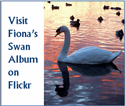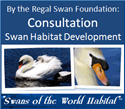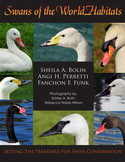Ask the Swan Specialist
Date: 5 February 2014
Hi Suzann:
The Australian Black Swans breed twice a year, once in the spring and again in the summer. You are going to have a lot of cygnets in a very short time. You will need to contact a swan breeder to see if you can find a new home for the cygnets once they reach 8-10 months of age as this is the age when the parents will begin chasing them away from the pond for the arrival of the new breeding season. Since the Black Swans produce twice a year, you may see the parents begin chasing the cygnet at 6 months of age.
Should you ever get a light colored cygnet called a Mearl or Silver swan, we know someone who is looking for that color and would give it a good home. So, if you get this lighter colored swan, please let us know.
Finally, a small pond, the size of a small swimming pool would be fine. Or, you can actually build a "lazy river" type pond for them. Think of a donut. The donut itself will be the water and the hole of the donut would be a small island. The donut would then be surrounded by grass. The donut would be approximately 6 feet wide and 60 feet long each side with a total of 120 feet in circumference. The depth of the pool only needs to be 3-4 feet. This will allow the swans to get much needed exercise and they could go around in circles, sit on the island and basically sun around the water.
This type of pool may save you money. You will need to dig the trench and line it with pond liner and have a water fill to add water and a drain to drain the pond unless you are going to put in some type of aerator/filter system. If you are not going to use a filtering system and the pond is not spring fed, you must drain and clean the pond daily. Otherwise, the birds can die of botulism or other poisoning.
Whether a swimming pool type pond or a lazy river type pond, you will need to keep the water flush with the ground to maintain a zero entrance. Swans, especially cygnets can fall of ramps or hurt their legs and feet from slick surfaces. Never use any slick surfaces such as plastic, newspaper (unless it is shredded and thickly placed).
Once a swan or cygnet severely injures its legs or feet it can get bumblefoot, splayed tendon or other ailments that there may be no cure and the bird must be euthanized. This brings up another point about handling the cygnet. Keep the handling of a cygnet to a minimum unless you know what you are doing or the bird can get splayed tendons, an almost impossible injury to treat.
Whatever type of pond you use, it needs to be fenced in top to bottom so that no predators can dig under the fencing or climb into the fencing. We're not sure which Palm Springs you are referring, but if it is in either California or Florida, you have bobcats, foxes, coyotes, raccoons which can kill the parents and cygnets, especially at night. In Florida, you have alligators and panthers that can climb in or dig under fencing. So, the pen needs to be reinforced, top to bottom.
Domesticated dogs and cats are also a problem and we have had many a swan owner tell us about a dog, cat or even children killing their swans. Therefore, fencing is a requirement.
We also need to alert you to the cygnet's nutritional needs. They and the parents need cracked corn (a filler that provides Vitamin A). Without Vitamin A, the swans can develop a neurological problem.
The cracked corn should be mixed 1/2 and 1/2 with poultry layer pellets. The poultry layer pellets provide them much needed minerals and vitamins such as magnesium, calcium, phosphorous and other micronutrients. Bread can be used as a treat, but too much can alter their blood chemistry.
Finally, provide fresh lettuce to supplement or replace (in winter) aquatic vegetation. They need vegetation and they will use your newly placed sod as a food source if you do not feed them adequately, and even then, you may see dirt in a short time.
When adding sod, ensure that no pesticides, fertilizers or other insecticides or other chemicals have been used on the sod. These chemicals can kill a young cygnet and make adult birds extremely ill if not poison them.
One last piece of information is to strongly suggest that you find an experience avian/waterfowl veterinarian with experience in the treatment and care of swans. At 1-3 weeks of age, the cygnet MUST be pinioned (rendered unable to fly-state laws). At 1-3 weeks, there is no need for anesthesia because the nerves and blood vessels have not completely matured. After this age, you will need to have the bird placed under anesthesia, which is much harder on a young or older bird.
We hope that this information is of benefit. The Regal Swan
Messages In This Thread
- Smallest size for pond for pair of black swans? -- Suzann -- 4 February 2014
- Re: Smallest size for pond for pair of black swans? -- The Regal Swan -- 5 February 2014
Ask the Swan Specialist is powered by
Tetra-WebBBS 5.30 Beta © 2006-2007 Tetra-Team






